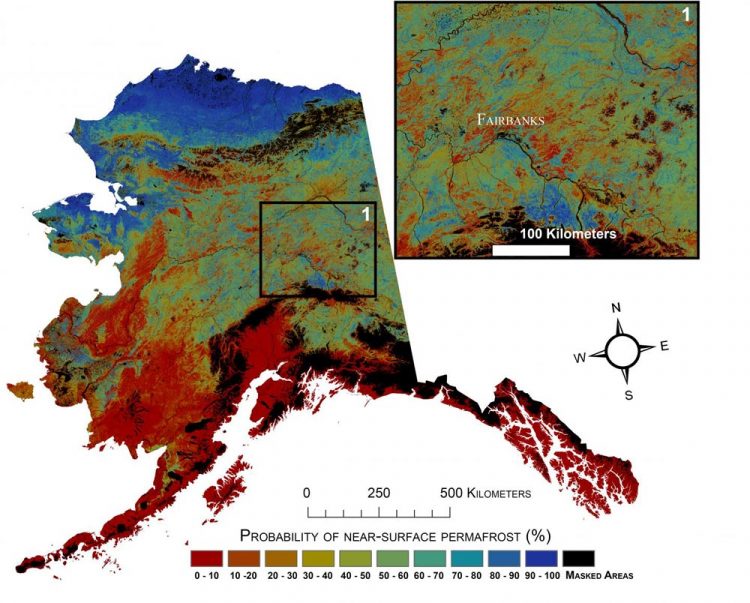USGS projects large loss of Alaska permafrost by 2100

See USGS press release (link) or research article for future scenarios. Credit: USGS
Northern latitude tundra and boreal forests are experiencing an accelerated warming trend that is greater than in other parts of the world. This warming trend degrades permafrost, defined as ground that stays below freezing for at least two consecutive years.
Some of the adverse impacts of melting permafrost are changing pathways of ground and surface water, interruptions of regional transportation, and the release to the atmosphere of previously stored carbon.
“A warming climate is affecting the Arctic in the most complex ways,” said Virginia Burkett, USGS Associate Director for Climate and Land Use Change.
“Understanding the current distribution of permafrost and estimating where it is likely to disappear are key factors in predicting the future responses of northern ecosystems to climate change.”
In addition to developing maps of near-surface permafrost distributions, the researchers developed maps of maximum thaw depth, or active-layer depth, and provided uncertainty estimates. Future permafrost distribution probabilities, based on future climate scenarios produced by the Intergovernmental Panel on Climate Change (IPCC), were also estimated by the USGS scientists.
Widely used IPCC climate scenarios anticipate varied levels of climate mitigation action by the global community.
These future projections of permafrost distribution, however, did not include other possible future disturbances in the future, such as wildland fires. In general, the results support concerns about permafrost carbon becoming available to decomposition and greenhouse gas emission.
The research has been published in Remote Sensing of Environment. The current near-surface permafrost map is available via ScienceBase.
Media Contact
All latest news from the category: Earth Sciences
Earth Sciences (also referred to as Geosciences), which deals with basic issues surrounding our planet, plays a vital role in the area of energy and raw materials supply.
Earth Sciences comprises subjects such as geology, geography, geological informatics, paleontology, mineralogy, petrography, crystallography, geophysics, geodesy, glaciology, cartography, photogrammetry, meteorology and seismology, early-warning systems, earthquake research and polar research.
Newest articles

Recovering phosphorus from sewage sludge ash
Chemical and heat treatment of sewage sludge can recover phosphorus in a process that could help address the problem of diminishing supplies of phosphorus ores. Valuable supplies of phosphorus could…

Efficient, sustainable and cost-effective hybrid energy storage system for modern power grids
EU project HyFlow: Over three years of research, the consortium of the EU project HyFlow has successfully developed a highly efficient, sustainable, and cost-effective hybrid energy storage system (HESS) that…

After 25 years, researchers uncover genetic cause of rare neurological disease
Some families call it a trial of faith. Others just call it a curse. The progressive neurological disease known as spinocerebellar ataxia 4 (SCA4) is a rare condition, but its…





















